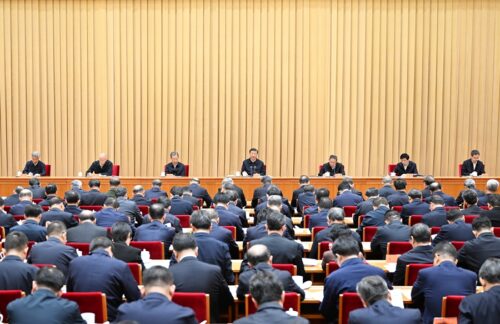China’s Two Sessions targets: A modernized military, economic recovery, and key technologies
Thousands of China’s top officials have convened in Beijing for the largest political gatherings of the year. While they’re mostly ceremonial, the ‘Two Sessions’ will outline Beijing’s most important political agendas for the year to come.

China unveiled a modest GDP forecast and a boost in military spending to kick off its largest political gathering of the year. This year’s round of key annual political gatherings, known as the “Two Sessions,” began on Saturday in Beijing for the first time since China scrapped its COVID-zero policy.
Over the course of the next two weeks, the Two Sessions will gather the more than 3,000 delegates to the country’s nominal legislature, the National People’s Congress (NPC), as well as around 2,000 members of Chinese People’s Political Consultative Conference (CPPCC), an advisory body.
The scholar Rory Truex of Princeton University’s Department of Politics and International Affairs, characterizes the NPC as “a rubber stamp” institution, while Sinologist Geremie Barmé calls the event a meeting of “two impotent bodies.” But the largely ceremonial gatherings will reveal new economic targets and other numbers, new policies, and the new leaders that will guide the government’s agenda. The public will get to see the results of Xí Jìnpíng 习近平 and his most trusted officials cementing their power in the major leadership reshuffle at last year’s 20th Party Congress.
A modest but healthy economic growth target
China announced a 5% GDP growth target, its lowest in more than three decades, as the country recovers from strict COVID-zero policies that largely kept it in isolation for the last three years. (It should be noted that 5% is still enviable by the standards of most countries.)
Lǐ Kèqiáng 李克强 announced the lower expectations during his final government work report in his position as premier at the National People’s Congress on Sunday. China earlier reported its second lowest growth rate in more than four decades at 3% for 2022, well below the 5.5% growth target set in last year’s iteration of the ‘Two Sessions’.
The target would put China in line with predictions of 5.2% economic growth from the IMF, driven by a rebound in domestic demand amid the surprise reopening in China.
The government also plans to create 12 million urban jobs in 2023 to boost its urban unemployment rate of around 5.5%. “Beijing’s target for 2023 would bring new urban employment to just below its pre-COVID level. Doable, but it’ll require a pretty quick recovery,” Gerard DiPippo, former CIA analyst and senior fellow of the economics program at CSIS, said on Twitter.
More defense spending, with an eye on Taiwan
China will boost its defense expenditure by 7.2% in 2023, according to a draft budget presented to the National People’s Congress. The increase to 1.55 trillion yuan ($224 billion) far exceeds the 5.7% increase in general public expenditure, in a sign that Beijing is doubling down on its efforts to modernize its defenses.
While China spends only a third of the funds that the U.S. shells out on defense, its military budget has continuously grown for the past three decades and is rumored to far exceed official numbers. Beijing increased defense spending by 7.1% in 2022 to 1.45 trillion yuan ($230.16 billion), compared to the 2% increase to just under $770 billion by the U.S. for the same year.
China’s military spending has also accelerated in recent years, ever since Xi outlined the country’s goal to “complete national defense and military modernization by 2035” in 2017. Much of those funds have been used to develop its naval and air forces: China’s third aircraft carrier, the Fujian, was launched last June and is expected to enter commission by next year.
The heightened military spending comes amid growing tensions with the U.S. Last week on March 2, the U.S. added 18 China-based entities to its trade blacklist for supporting “the PRC’s military modernization efforts,” and for “supplying or attempting to supply a sanctioned entity in Iran.” In December, U.S. President Joe Biden signed a record-breaking $858 billion Department of Defense (DOD) budget for 2023 that sets China firmly in its sights.
In his address, Li Keqiang also urged for “the peaceful development of cross Strait relations and advance the process of China’s peaceful reunification,” amid heightened regional tensions in the Indo-Pacific. According to the Washington, D.C.-based think tank Center for Strategic and International Studies (CSIS), China spent more on defense than the next 13 Indo-Pacific economies combined as of 2021.
Both Japan and Taiwan have announced landmark changes within the last year to beef up their defenses, in an effort to deter China’s growing military might. Taiwan extended its mandatory military service for young men from four months to one year beginning in 2024, while Japan announced that it would double its defense spending over the next five years to 2% of its GDP.
AI and chips will drive Chinese modernization
Meanwhile, China appears to be overhauling its tech sector to focus on strategic areas, as part of a broader effort to boost its self-sufficiency in key technologies. Xi reiterated calls for high-quality development in Chinese modernization, and many of the new or existing NPC delegates come from industries such as artificial intelligence (AI), cloud computing, semiconductors, and hardware.
China’s finance ministry and state planner, the National Development and Reform Commission (NDRC), followed up on Xi’s pledge with plans to boost special funds to support chip development and other key industrial sectors by nearly 50% from last year to 4.4 billion yuan. China also announced plans to build around 600,000 5G base stations this year, bringing the total to more than 2.9 million by the end of 2023.
Beijing’s shifting policy focus comes as the U.S. and its allies have ramped up efforts to curb China’s access to chipmaking equipment and other key pieces of tech. The U.S. is also considering new rules to stop American investments in such advanced technologies in China.
“It’s important to realize that Chinese development of these technologies does not depend on U.S. investment,” Malia Du Mont, a former Pentagon official with China expertise, told The China Project in February. “The U.S. is increasing domestic investment in key technologies through the CHIPS and Science Act, but China has long been prioritizing their own investments in these technologies in a bid to become a global leader in scientific and technological innovation, and that trend will not stop.”
Useful links:
- Links to government work report, budget report, and other Two Sessions documents / Zichen Wang’s Twitter feed
- Xi Jinping’s first speech in Two Sessions / Ginger River
- Li’s work report; Xi on securing rice bowl and manufacturing; leading cadres bow to Xi’s leadership and two establishments / Tracking people’s Daily






